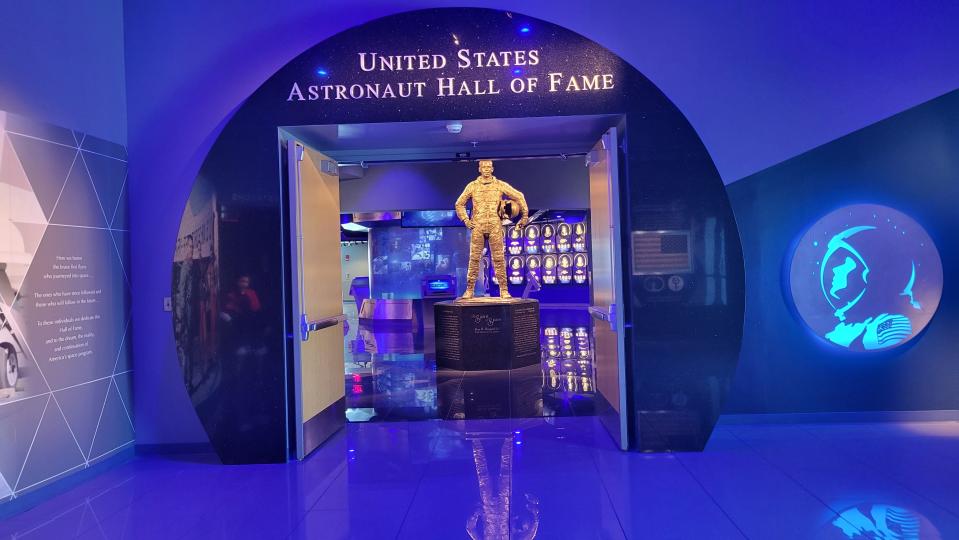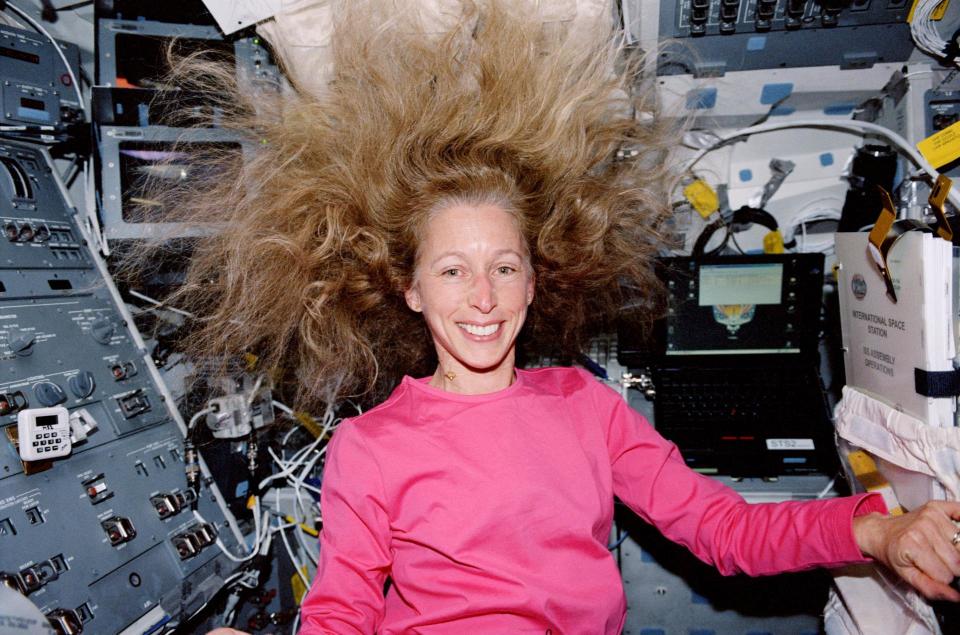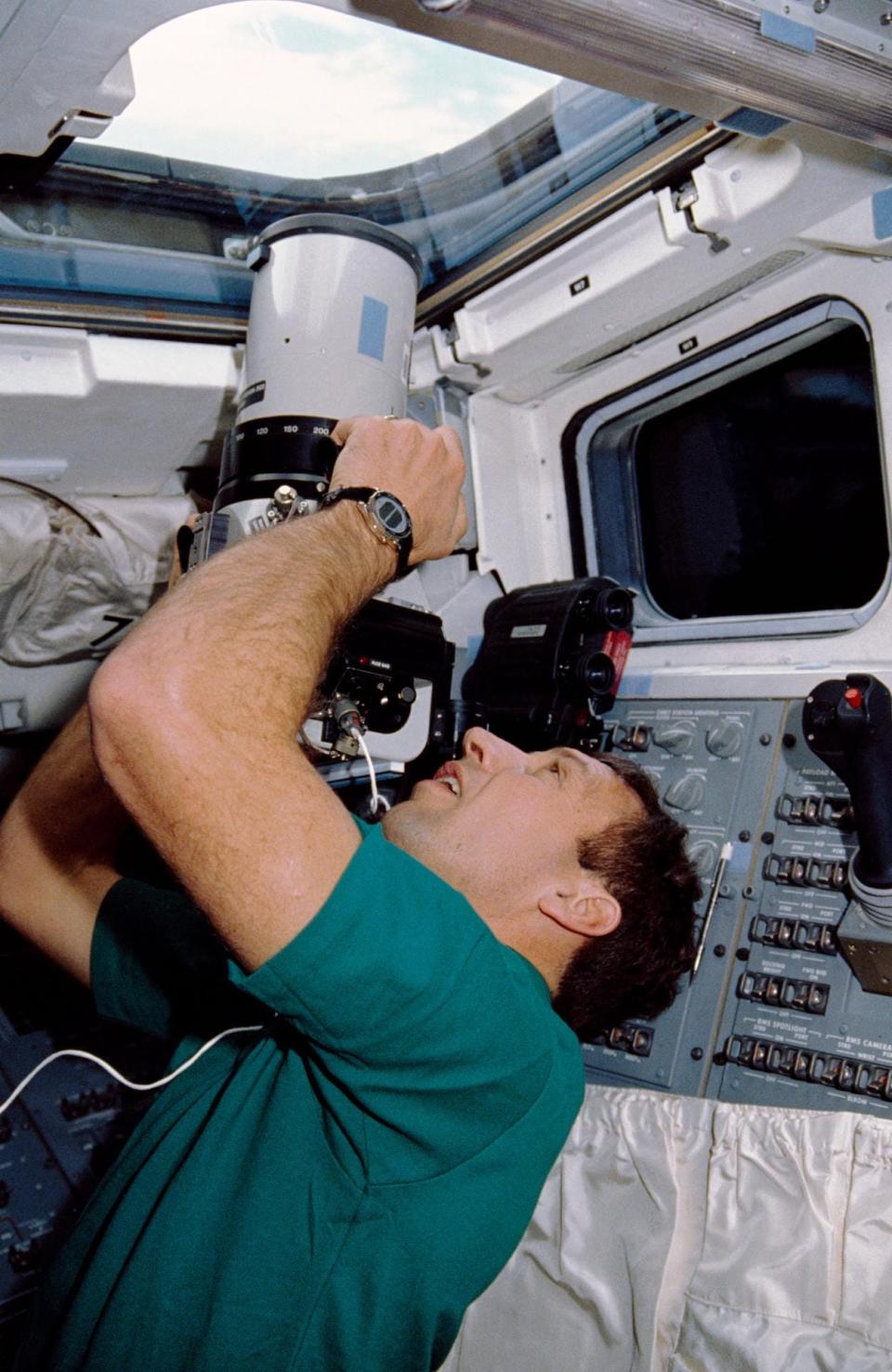Meet the two NASA Astronauts being added to the Astronaut Hall of Fame
- Oops!Something went wrong.Please try again later.
Two astronauts are set to be inducted into the Astronaut Hall of Fame on Saturday, joining an ever-growing group of space explorers recognized for their achievements in space exploration. What started as a commemoration of the Mercury Seven astronauts has grown significantly.
Marsha Ivins, who flew on five space shuttle missions and also spent time on the former Russian space station Mir, and David Hilmers, who flew to space four times including the first launch post-Challenger, are the 2024 inductees. Both are retired from NASA with Hilmers now on a mission to eradicate Hepatitis B, and Ivins working in human factors engineering as Sophic Synergistics' director of human system integration.
This year's Astronaut Hall of Fame ceremony, held annually by Delaware North at Kennedy Space Center Visitor Complex, will be conducted under the Space Shuttle Atlantis — a spacecraft of special significance to Irvins and Hilmers as both flew on that orbiter. The event is open to park ticket holders. The Visitor Complex website notes that seating is available on a first-come, first-serve basis.
"It's a beautiful kind of pomp and circumstance ceremony," said Caroline Schumacher, president and CEO of the Astronaut Scholarship Foundation, which started the Hall of Fame.
This story began 40 years ago in 1984 — not only the year that Ivins was selected as an astronaut, but the year that the Astronaut Scholarship was conceived.
Don't miss the next Florida launch: Is there a launch today? Upcoming SpaceX, NASA, ULA rocket launch schedule in Florida
Astronaut Hall of Fame History

If you have been to the Kennedy Space Center Visitor Complex, chances are you've seen the Astronaut Hall of Fame exhibit. The Hall of Fame sits inside the Heroes and Legends building near the famed rocket garden. After getting a glimpse into the heroes of the early American space program, visitors are able to walk through the Astronaut Hall of Fame, which displays illuminated plaques of inductees. These plaques include the portrait, name and their space missions.
It is the Astronaut Scholarship Foundation which started the Astronaut Hall of Fame, and continues to keep its yearly tradition alive by selecting the inductees and raising funds for scholarships to empower future trailblazers.
"The Astronaut Scholarship Foundation was originally called the Mercury Seven Foundation," Schumacher said. "We were founded 40 years ago in 1984 by, at that time, the six surviving Mercury astronauts, Betty Grissom − the wife of Gus Grissom, and philanthropist Henri Landwirth."
She said that while the group got together annually, they decided in 1984 that there should be something to carry on their legacy.
"It was actually their friend, Henri, who sparked this interest, and he managed the Starlight motel where all the astronauts and the media stayed," said Schumacher.
"And so they said they wanted to really promote youth and young people to pursue science and technology," she said.
The group settled on a scholarship which would be awarded to juniors and seniors at the college level, and in 1986, awarded seven scholarships − one for each original Mercury astronaut.
Today the organization has awarded close to 800 scholarships.
The Original Astronaut Hall of Fame
Eventually the Astronaut Scholarship Foundation sought to do more, bringing to life the Astronaut Hall of Fame in 1990. Originally it was in a regular museum in Titusville which displayed the inductees' plaques. But in 2016, it was relocated and integrated into the new Heroes and Legends exhibit within Kennedy Space Center Visitor Complex.
After the two inductees see their plaques added to the exhibit, the ceremony will continue Saturday evening with a gala at the Visitor Complex's Saturn V Center, that will support the Astronaut Scholarship Foundation. Tickets are on sale for the gala, starting at $475 − which includes reserved seating at the induction ceremony, transportation and dinner at the gala, and admission to the after party at Hilton Cocoa Beach.
The funds support the Astronaut Scholarship Foundation.
Who is Marsha Ivins

Marsha Ivins was born in Baltimore, Maryland on April 15, 1951.
She graduated from Nether Providence High School in Wallingford, Pennsylvania, in 1969, before going on to receive her B.S. in aerospace engineering from the University of Colorado in 1973.
A year later, Ivins was hired into NASA as an engineer for orbiter displays and controls and crew machine engineering at the Lyndon B. Johnson Space Center. She also worked on the development of the Space Shuttle Orbiter Heads-Up Display (HUD). According to NASA, the HUD provided shuttle pilots with a view of flight data.
In 1980, she transitioned to working as a flight engineer on the Shuttle Training Aircraft and as a co-pilot in the NASA administrative aircraft.
Ivins was selected by NASA in 1984 as part of the 10th class of astronauts, and the third class to include female candidates.
Ivins flew in space on five missions: STS-32 in 1990, STS-46 in 1992, STS-62 in 1994, STS-81 in 1997 and STS-98 in 2001, flying aboard Atlantis and Columbia.
She racked up 1318 hours in space, spending time on the Russian space station in 1997, and assisting with the installation of the Destiny module to the International Space Station in 2001.
Even though she retired from NASA in 2010, Ivins continued to be active, sharing her knowledge of space exploration. According to a USA Today article, Ivins provided technical insight into the 2014 movie Interstellar, including making sure details as small as the ship’s docking port were accurate.
According to the Kennedy Space Center Visitor Complex press release, Ivins currently works at Houston-based company Sophic Synergistics. Sophic Synergistics was founded by Cynthia Rando, a former NASA Johnson Space Center employee. In 2022, the company announced a partnership with Axiom Space − which was award a contract by NASA to develop the next generation of extravehicular activity (EVA) suits.
David Hilmers

David Hilmers was born on January 28, 1950, in Clinton, Iowa. He claims DeWitt, Iowa, where he graduated high school in 1968, to be hometown, according to a release from NASA’s Lyndon B Johnson Space Center.
Hilmers received his B.A. in mathematics from Cornell College in 1972, graduating summa cum laude, before joining the Marine Corps in July of that year. Hilmers served in all three Marine Corps aviation wings and with the Second Marine Division as a forward air controller.
While in the Marine Corps, Hilmers gained a M.S. degree in electrical engineering and the degree of electrical engineer from the U.S. Naval Postgraduate School.
In 1980, just after completing a tour with the 1st Marine Aircraft Wing in Iwakuni, Japan, Hilmer was selected by NASA as part of the 9th class of astronauts. When he received the call from NASA, he was stationed with the 3rd Marine Aircraft Wing in El Toro, California.
Before flying on his first mission, Hilmer worked on multiple projects, including working on Department of Defense payloads and served as a spacecraft communicator (CAPCOM) at Mission Control for STS-41D, STS-41G, and STS-51A.
Hilmer went on to fly in space four times: STS-51-J in 1985, STS-26 in 1988, STS-36 in 1990 and STS-42 in 1992 onboard Atlantis and Discovery.
Hilmer’s first spaceflight was also the first flight of the Space Shuttle Atlantis. The STS-51-J mission launched on October 3, 1985, carrying a classified Department of Defense payload.
His second spaceflight was STS-26 on Shuttle Discovery in 1988. That was the first launch after the Challenger disaster.
Hilmer logged more than 493 hours in space before retiring from NASA in October of 1992.
He went on to attend Baylor College of Medicine, where he finished medical school and residencies in internal medicine and pediatrics. With this, Hilmer obtained his Master of Public Health degree.
According to the Kennedy Space Center Visitor Complex press release, Hilmer currently serves as the Chief Medical Officer for Dr. Alice Lee’s (his wife) non-government organization, Hepatitis B Free (HBF). Based in Australia, the organization is on a mission to eliminate Hepatitis B “through prevention, testing and treatment”.
Astronaut Hall of Fame Requirements
To get named to the Astronaut Hall of Fame, here are the basic requirements the candidates must possess.
His or her first flight was at least 15 years before the induction.
The last day eligible for a NASA flight assignment was at least five years before the candidate's nomination.
Candidate must be a U.S. citizen.
The candidate must have served as a NASA-trained space shuttle commander, pilot, mission specialist, International Space Station commander, or flight engineer.
The candidate must have orbited Earth at least once.
Brooke Edwards is a Space Reporter for Florida Today. Contact her at bedwards@floridatoday.com or on X: @brookeofstars.
This article originally appeared on Florida Today: Two NASA astronauts to be added to Astronaut Hall of Fame at KSC VC

